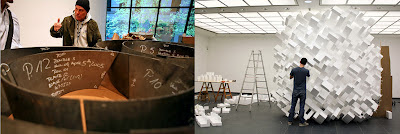I'm traveling to Vyksa Russia today to take part in an arts festival. Vyska is home to a water-tower, built by the engineer/architect Vladimir Shukhov for a local metallurgic plant. The festival is built on realizing a connection between Revolutionary Russia of the early 20th century and the "street-art" of today. I won't be making any street-art, but I will be working "in situ"
Incredibly (for an American), the bridging document is a Russian Futurist manifesto from 1918:
Decree #1 on the Democratization of Art (the hoarding of literature and the painting on streets) Comrades and citizens, we, the leaders of Russian futurism – the revolutionary art of youth – declare:Richard Serra's "Site Specific" preparations for Band (2006); John Powers "In Situ"construction of Fat Bastard (2010)
1. From this day forward, with the abolition of tsardom, the domicile of art in the closets and sheds of human genius – palaces, galleries, salons, libraries, theaters — is abrogated.
2. In the name of the great march of equality for all, as far as culture is concerned, let the Free Word of creative personality be written on the corners of walls, fences, roofs, the streets of our cities and villages, on the backs of automobiles, carriages, streetcars, and on the clothes of all citizens.
3. Let pictures (colors) be thrown, like colored rainbows, across streets and squares, from house to house, delighting, ennobling the eye (taste) of the passer-by. Artists and writers have the immediate duty to get hold of their pots of paint and, with their masterly brushes, to illuminate, to paint all the sides, foreheads, and chests of cities, railway stations, and the evergalloping herds of railway carriages.
From now on, let the citizen walking down the street enjoy at every moment the depths of thought of his great contemporaries, let him absorb the flowery gaudiness of this day’s beautiful joy, let him listen to music — the melody, the roar, the buzz — of excellent composers everywhere. Let the streets be a feast of art for all.
And if all this comes to pass, in accordance with our word, everyone who goes out into the street will grow to be a giant and in wisdom, contemplating beauty instead of the present-day streets with their iron books (signboards), where every page has been written on their signs by greed, the lust for mammon, calculated meanness and low obtuseness, all of which soil the soul and offend the eye. “All art—to all the people!” The initial pasting up of the poems and hanging of pictures will take place in Moscow on the day our journal is published,
Mayakovsky, Kamensky, Burlluk. (“Futurists’ Journal” - March 15, 1918)
I am not at all a street-artist, but I do not feel I am out of step with the aims of the festival. My contribution will be to build a "tower" using wood blocks in situ. This does not mean the work will be "site specific" in some grand theoretical terms. Already played-out when I first began doing installation work in 1995, Richard Serra proved once and for all just how attenuated and meaningless "site specific" had become in 2006, with the installation of his monstrous "site specific" work Band for his retrospectives at MoMA and LACMA (Band was billed as "site specific" for both venues). In situ it means it will be conceived and built on the exact spot where it will be shown and live out its objecthood. My career has provided many opportunities to build pieces in situ - but almost all of them have been indoors. Rather than make a piece in the studio to bring to Russia, my preparations for the festival amount to little more than a wish list:
A - 50 mm x 100 mm x 150 mm - 800 pieces
B - 75 mm x 150 mm x 225 m - 500 pieces
C - 100 mm x200 mm x 300 mm - 250 pieces
D - 150 mm x 300 mm x 450 mm - 150 pieces




No comments:
Post a Comment